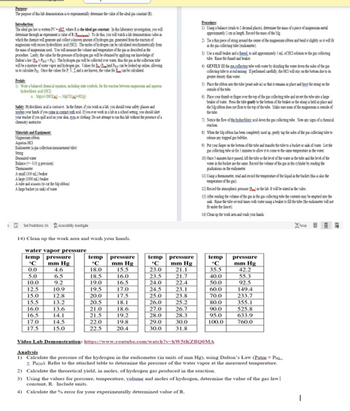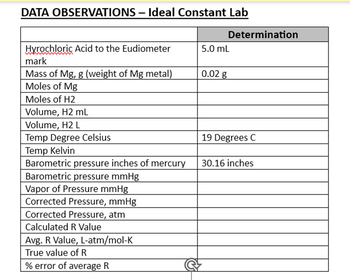
Chemistry
10th Edition
ISBN: 9781305957404
Author: Steven S. Zumdahl, Susan A. Zumdahl, Donald J. DeCoste
Publisher: Cengage Learning
expand_more
expand_more
format_list_bulleted
Question

Transcribed Image Text:Purpose
The purpose of this la demonstration is to experimentally determine the value of the ideal gas constant (X).
The ideal gas law is wien PV-RI, where is the ideal gas constant. In this laboratory investigation, you will
determine through an experiment a value of RO To do this, you will watch a lab demonstration video in
which the chemist will generate and collect a known amount of hydrogen pas, generated from the reaction of
magnetism with excess hydrochleic acid (HC) The moles of hydropem can be calculated strictionically from
dhe mass of magsimused. You will measure the volume and temperature of the gas as described in the
procedure. Lastly, the value for the pressure of hydrogen gas will be obtained by applying our knowledge of
Dalton's law Pao+Pa) The bydroges gas will be collected over water, thus the gas in the collection tube
will be a mixture of water vapor and hydrope gas Values for 2 Pamand Proo can be looked up celine, allowing
us to calculate Py. Once the values for P. V. I and are known, the value for can be calculated
Probab
1) White a balanced chemical equation, including state symbols, for the reaction betwee main and aqueous
hydrochloric acid (HC)
Mg-C-My-H
Safety Hydrochloric acid is comive. In the future, if you work in a lab, you should wear safety glasses and
be your hands if you come in contact with acid. If you ever werk in a lab in a school seting, you should al
your teacher if you spill acid on your skin, y or clothing. Do not atempt to run this lab without the presence of a
chenisty mutritiase,
Maturiths and Tquipmut:
Magnee
Aqueous HC1
Eudiometer (agas collection tube)
Sering
Deind water
Balance (-0.01 precision)
Theme
A small (300ml) beaker
A large (1000) bek
A ruler and scissons (to cut the Mgibbox)
A large bucket (nt somk) of water
sa Predictions On
Accia
14) Clean up the work area and wash your hands.
water vapor pressure
temp
'C
0.0
5.0
10.0
12.5
15.0
15.5
16.0
16.5
17.0
17.5
▬▬▬▬
pressure
mm Hg
4.6
6.5
9.2
10.9
12.8
13.2
13.6
14.5
15.0
temp pressure
'C
mm Hg
18.0
15.5
16.0
16.5
17.0
17.5
18.1
18.6
19.2
19.8
20.4
18.5
19.0
19.5
20,0
20.5
21.0
21.5
22.0
22.5
temp pressure
'C
mm Hg
23.0
21.1
23.5
21.7
24.0
22.4
24.5
25.0
26.0
27.0
28.0
29.0
30.0
23.1
23.8
25.2
26,7
28.3
30.0
31.8
Procedure
1) Uing a balance (rads to 2 decimal places), determine the mass of a piece of magnesin metal
approximately 2 cm in length. Record the man of the Mg
2) The athin piece of string around the one of the magnesium nibbon and bend it slightly so it will f
in the gas collecting the (edit)
3) Use a small beaker and a free to add approximately 5 mL of HCl solution to the gas collecting
tube Rise the fame and beaker
4 GENTLY El te te collecting the waith water ky drizzling the water down the side of the pas
collecting tube to avoid ming performed carefully, the HCI will stay on the bottom due to its
greater deity than water
5) Place the ribbon to the tube (poist side is) so that it remains in place and have the string on the
outside of the tube
6) Place your thumb or finger over the top of the gas collecting tube and invert the tobe into a large
beaker of water Press the tube gay to the bottom of the beaker so the string is held is place and
the Me tibbon does not lost to the top of the he. Make sure note of the magnesium is outside of
7) Notice the flow of the
chloric acid down the gas collecting tube. Note any signs of a chemical
1) When the Mbon has been completely used up, gently tap the sides of the gas collecting beto
release trapped gas bubbles
9) Put your finger on the bottom of the tube and trander the tube to a bucket or sink of water. Let the
gas collecting tube sit for 5 minutes to allow it to come to the same temperature as the water.
10) Once 5 minutes have passed the tube so the level of the water in the tube and the level of the
water in the bucket are the same. Record the velme of the gas in the cylinder by reading the
graduation on the endometer
11) Unga theme, read and record the temperature of the liquid in the bucket (this is the
temperation of the par)
12) Record the mospheric pressure (R) in the lab It will be stated in the video.
13) After reading the volume of the pas in the gas collecting the the contents may be empted into the
sink Rinse the tube several times with water using a beaker to fill the tube (the one will not
ft under the face
14) Clean up the work area and wash your hands
temp
'C
35.5
40.0
50.0
60.0
70.0
80.0
90.0
95.0
100.0
pressure
mm Hg
42.2
55.3
92.5
149.4
233.7
355.1
525.8
633.9
760.0
Video Lab Demonstration: https://www.youtube.com/watch?v=hWS(KZBQOMA
Analysis
1) Calculate the pressure of the hydrogen in the eudiometer (in units of mm Hg), using Dalton's Law (Patio - Pa
± Pico). Refer to the attached table to determine the pressure of the water vapor at the measured temperature.
2) Calculate the theoretical yield, in moles, of hydrogen gas produced in the reaction.
3) Using the values for pressure, temperature, yolume and moles of hydrogen, determine the value of the gas law
constant, R. Include units.
4) Calculate the % error for your experimentally determined value of R.
Focus

Transcribed Image Text:DATA OBSERVATIONS - Ideal Constant Lab
Hyrochloric Acid to the Eudiometer
mark
Mass of Mg, g (weight of Mg metal)
Moles of Mg
Moles of H2
Volume, H2 mL
Volume, H2 L
Temp Degree Celsius
Temp Kelvin
Barometric pressure inches of mercury
Barometric pressure mmHg
Vapor of Pressure mmHg
Corrected Pressure, mmHg
Corrected Pressure, atm
Calculated R Value
Avg. R Value, L-atm/mol-K
True value of R
% error of average R
Determination
5.0 mL
0.02 g
19 Degrees C
30.16 inches
Expert Solution
This question has been solved!
Explore an expertly crafted, step-by-step solution for a thorough understanding of key concepts.
This is a popular solution
Trending nowThis is a popular solution!
Step by stepSolved in 7 steps

Knowledge Booster
Learn more about
Need a deep-dive on the concept behind this application? Look no further. Learn more about this topic, chemistry and related others by exploring similar questions and additional content below.Similar questions
- Consider the following reaction in which all reactants and products are gases. P4+6 Cl2 –→ 4PC13 A 100. mL reactor vessel is charged with 250. mg of P4 and 4.21 atm of Cl2 at 298 K. The reaction goes to completion. How many moles of chlorine gas are initially in the vessel? moles Cl2 BACK Question 5 of 6 NEXT> étv A 888 F4 FI FS F7 & % 5 %23 2 3 4 E т Yarrow_forwardA student reads a barometer in the laboratory and finds the prevailing atmospheric pressure to be 705 mm Hg. Express this pressure in atmospheres, kilopascals, torrs, pounds per square inch, and pascals. Hint: 1 atm = 101.3 kPa = 760 torr = 760 mm Hg = 14.69 psi = 1.013x10 Pa mm Hg atm kPa torr psi Ра 705 Submit Answer Retry Entire Group 2 more group attempts remaining Previous Nextarrow_forwardThree samples of three different gases are listed in the table below. All the samples contain exactly 1 mole of gas and are at a temperature of 0.0°C. For each sample, decide whether the gas can be reasonably described as an ideal gas. If the gas isn't ideal, decide the most important reason why it isn't. 圖 pressure volume If not ideal, the most sample ideal? (atm) (L) important reason why not: olo O yes O There are attractions between the particles. A 2.9 10.0 O no O The particles don't have zero volume. O yes O There are attractions between the particles. В 1.3 20.0 O no O The particles don't have zero volume. O yes O There are attractions between the particles. 0.60 30.0 O no O The particles don't have zero volume. ? Explanation Check O 2020 McGraw-Hill Education. All Rights Reserved. Temms of Use | Privacy | Accessibilityarrow_forward
- Chrome File Edit View History Bookmarks People Tab Window Help 80% Tue 8:42 PM Chem 101 HW 101 Chem101 + app.101edu.co E Question 22 of 25 Submit How many moles of NH3 form when 32.4L of H2 gas completely reacts at STP according to the following reaction? Remember 1 mol of an ideal gas has a volume of 22.4 L at STP N2(g) + 3 H2(g) → 2 NH3(g) STARTING AMOUNT ADD FACTOR ANSWER RESET *( ) 0.964 22.4 1.45 0.482 16.4 2 1 17.03 4.34 32.4 2.02 6.022 x 1023 g H2 mol H2 g/mol NH3 mol NH3 LH2 g/mol H2 g NH3 L NH3 PAGES W +arrow_forwardHi! I am unsure of how to solve this problem. Thank you!arrow_forwardCalculate the molar mass for a gas from the following lab data: (R= 0.0821 L atm/K mol). Given: - weight of gas= 0.271 g - volume= 153 mL - pressure= 750 mm - temperature= 101 Carrow_forward
- Help please with this factorsarrow_forwardplease solve part b question 4 ASAP just have less time and do not give wrong answer pleasearrow_forward&drc-D0&gi-24758088- A flexible lighting fixture is filled with neon. The starting volume of the fixture is 8.2L and the pressure of the neon is 3.2 atm. If the fixture is compressed, reducing the volume to 1.6L, what is the new pressure in the lamp? Your Answer: Answer units D Add attachments to support your workarrow_forward
- Exercise 10.129 Review A gas mixture contains 75.2% nitrogen and 24.8% krypton by mass. Part A What is the partial pressure of krypton in the mixture if the total pressure is 785 mmHg ? Express your answer with the appropriate units. PKr = Value Unitsarrow_forwardNumber 2arrow_forwardce3true&aPP gle Search 5/1 6. At constant pressure, the volume of a fixed mass of an ideal gas is directly proportional to the absolute temperature. TRUE FALSEarrow_forward
arrow_back_ios
SEE MORE QUESTIONS
arrow_forward_ios
Recommended textbooks for you
 ChemistryChemistryISBN:9781305957404Author:Steven S. Zumdahl, Susan A. Zumdahl, Donald J. DeCostePublisher:Cengage Learning
ChemistryChemistryISBN:9781305957404Author:Steven S. Zumdahl, Susan A. Zumdahl, Donald J. DeCostePublisher:Cengage Learning ChemistryChemistryISBN:9781259911156Author:Raymond Chang Dr., Jason Overby ProfessorPublisher:McGraw-Hill Education
ChemistryChemistryISBN:9781259911156Author:Raymond Chang Dr., Jason Overby ProfessorPublisher:McGraw-Hill Education Principles of Instrumental AnalysisChemistryISBN:9781305577213Author:Douglas A. Skoog, F. James Holler, Stanley R. CrouchPublisher:Cengage Learning
Principles of Instrumental AnalysisChemistryISBN:9781305577213Author:Douglas A. Skoog, F. James Holler, Stanley R. CrouchPublisher:Cengage Learning Organic ChemistryChemistryISBN:9780078021558Author:Janice Gorzynski Smith Dr.Publisher:McGraw-Hill Education
Organic ChemistryChemistryISBN:9780078021558Author:Janice Gorzynski Smith Dr.Publisher:McGraw-Hill Education Chemistry: Principles and ReactionsChemistryISBN:9781305079373Author:William L. Masterton, Cecile N. HurleyPublisher:Cengage Learning
Chemistry: Principles and ReactionsChemistryISBN:9781305079373Author:William L. Masterton, Cecile N. HurleyPublisher:Cengage Learning Elementary Principles of Chemical Processes, Bind...ChemistryISBN:9781118431221Author:Richard M. Felder, Ronald W. Rousseau, Lisa G. BullardPublisher:WILEY
Elementary Principles of Chemical Processes, Bind...ChemistryISBN:9781118431221Author:Richard M. Felder, Ronald W. Rousseau, Lisa G. BullardPublisher:WILEY

Chemistry
Chemistry
ISBN:9781305957404
Author:Steven S. Zumdahl, Susan A. Zumdahl, Donald J. DeCoste
Publisher:Cengage Learning

Chemistry
Chemistry
ISBN:9781259911156
Author:Raymond Chang Dr., Jason Overby Professor
Publisher:McGraw-Hill Education

Principles of Instrumental Analysis
Chemistry
ISBN:9781305577213
Author:Douglas A. Skoog, F. James Holler, Stanley R. Crouch
Publisher:Cengage Learning

Organic Chemistry
Chemistry
ISBN:9780078021558
Author:Janice Gorzynski Smith Dr.
Publisher:McGraw-Hill Education

Chemistry: Principles and Reactions
Chemistry
ISBN:9781305079373
Author:William L. Masterton, Cecile N. Hurley
Publisher:Cengage Learning

Elementary Principles of Chemical Processes, Bind...
Chemistry
ISBN:9781118431221
Author:Richard M. Felder, Ronald W. Rousseau, Lisa G. Bullard
Publisher:WILEY